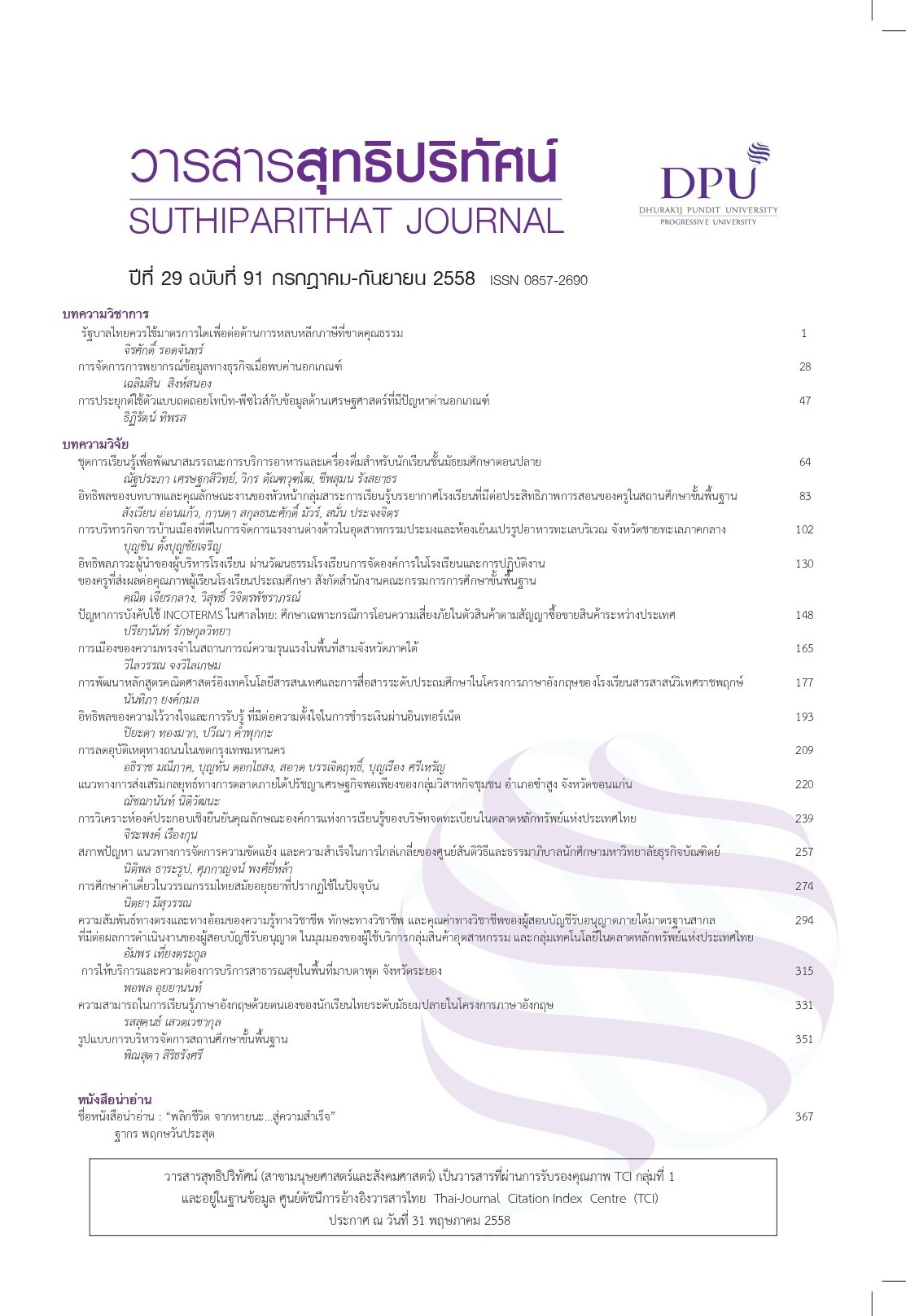อิทธิพลของความไว้วางใจและการรับรู้ที่มีต่อความตั้งใจในการชำระเงินผ่านอินเทอร์เน็ต
คำสำคัญ:
ความตั้งใจในการชำระเงินผ่านอินเทอร์เน็ต, ความไว้วางใจ, การรับรู้ความเสี่ยง, การรับรู้ความง่าย, การรับรู้ประโยชน์บทคัดย่อ
การวิจัยครั้งนี้มีวัตถุประสงค์เพื่อศึกษาอิทธิพลของความไว้วางใจและการรับรู้ที่มีผลต่อความตั้งใจ ในการชำระเงินผ่านอินเทอร์เน็ต ตัวอย่างที่ใช้ในการวิเคราะห์ครั้งนี้ คือ ผู้ที่เคยชำระเงิน ผ่านอินเทอร์เน็ตแบ้งกิ้ง จำนวน 400 คน ทำการสุ่มตัวอย่าง ด้วยวิธีการสุ่มตัวอย่างแบบสะดวก เครื่องมือที่ใช้ในการวิจัย คือ แบบสอบถาม สถิติที่ใช้ในการวิเคราะห์ข้อมูล ได้แก่ ความถี่ ร้อยละ ค่าเฉลี่ย ส่วนเบี่ยงเบนมาตรฐาน การทดสอบ t-Test F-Test และการวิเคราะห์ความถดถอยเชิงพหุ
ผลการวิจัยพบว่า ความไว้วางใจของการชำระเงินผ่านอินเทอร์เน็ต การรับรู้ความเสี่ยงในการใช้งาน การรับรู้ความง่ายในการใช้งาน และการรับรู้ประโยชน์ ของการชำระเงินผ่านอินเตอร์เน็ต มีอิทธิพลต่อความตั้งใจในการชำระเงินผ่านอินเทอร์เน็ตอย่างมีนัยสำคัญทางสถิติที่ระดับ 0.05 โดย สามารถอธิบายการเปลี่ยนแปลงของความตั้งใจในการชำระเงินผ่านอินเทอร์เน็ตได้ร้อยละ 56
เอกสารอ้างอิง
กระทรวงเทคโนโลยีสารสนเทศและการสื่อสาร. (2556). แผนแม่บทเทคโนโลยีสารสนเทศและการสื่อสาร (ฉบับที่ 3) ของประเทศไทย พ.ศ. 2557-2561. สำนักงานปลัดกระทรวงเทคโนโลยีสารสนเทศและการสื่อสาร.
ณสิตา ราชาดี. (2553). สาเหตุและผลลัพธ์ของความตั้งใจเชิงพฤติกรรมของลูกค้าบน e-Jewelry. (วิทยานิพนธ์ ปริญญาบริหารธุรกิจมหาบัณฑิต). กรุงเทพฯ: มหาวิทยาลัยรามคำแหง.
ธนาคารแห่งประเทศไทย. (2557). รายงานระบบการชำระเงิน 2556. รายงานประจำปี 2556.: ฝ่ายระบบชำระเงินธนาคารแห่งประเทศไทย.
นิติ ปุรินทราภิบาล. (2551). ความสัมพันธ์ระหว่างปัจจัยตามทฤษฏีการกระทำ ตามแผนกับพฤติกรรมเสี่ยงต่อการเกิด อุบัติเหตุ ของคนงานก่อสร้าง. (วิทยานิพนธ์วิศวกรรมศาสตมหาบัณฑิต). กรุงเทพฯ: จุฬาลงกรณ์มหาวิทยาลัย.
นิธินาถ วงศ์สวัสดิ์. (2555). ความตั้งใจในการซื้อขายหลักทรัพย์ผ่านอินเทอร์เน็ต. (วิทยานิพนธ์บริหารธุรกิจ มหาบัณฑิต). อุบลราชธานี: มหาวิทยาลัยอุบลราชธานี.
ปวีณา คำพุกกะ. (2556). สถิติธุรกิจ. อุบลราชธานี : โรงพิมพ์มหาวิทยาลัยอุบลราชธานี.
ลินดา หลวงมาลัย. (2554). ผลกระทบของความเชื่อในการไว้วางใจในพาณิชย์อิเล็กทรอนิกส์ของเว็บไซต์สิรินดา สตอรี่ที่มีต่อเจตนาในการไว้วางใจของผู้เข้าชม. (การค้นคว้าอิสระปริญญาบริหารธุรกิจมหาบัณฑิต), เชียงใหม่: มหาวิทยาลัยเชียงใหม่.
สำนักงานสถิติแห่งชาติ. (2555) รายงานวิจัยผลสำรวจการมีการใช้เทคโนโลยีสารสนเทศและการสื่อสารในครัวเรือน พ.ศ. 2555. กรุงเทพฯ : กระทรวงเทคโนโลยีสารสนเทศและการสื่อสาร.
Alessandro, D. S., Girardi, A., Tiangsoongnern, L. (2012). (Perceived risk and trust as antecedents of online purchasing behavior in the USA gemstone industry. Asia Pacific Journal of Marketing, 24(3), 433-460 Retrieved May 25, 2013, from http://www.emeraldinsight.com
Assael, H. (1998). Consumer Behavior and The Marketing Action (6th ed.). Cinninnati, Ohio: International Thomson Publishing
Becerra, E. P & Korgaonkar, P.K. (2011). Effects of trust beliefs on consumer’online intention. European Journal of Marketing, 45(6): 936-962. Retrieved May 2, 2013, from http://www.emeraldinsight.com
Bianchi, C & Andrews, L. (2012). Risk, trust, and consumer online purchasing behavior: a Chilean perspective. International Marketing Review, 29(3), 253-276. Retrieved September 5, 2013, from http://www.sciencedirect.com
Davis, F. D. (1991). User acceptance of information technology: system characteristics, user perceptions and behavioral impacts. J.Man-Machine Studies, 38, 475-487. Retrieved May 11, 2013, from http://www.sciencedirect.com
He, D., Yaobin, L. Y., & Zhou, D. (2008). Empirical Study of Consumers’ Purchase Intentions in C2C Electronic Commerce. Tsinghua Science and Technology, 13(3), 287-292 Retrieved September 5, 2013, from http://www.sciencedirect.com
Limbu Y. B., Wolf M., & Lunsford, D. (2012). Perceived ethics of online retailers and consumer behavioral intentions. Journal of Indian Research, 6(2), 133-154. Retrieved May 2, 2013 from http://www.emeraldinsight.com
Mafe, R. C., Blas, S. S., & Manzano, J. A. (2009). Drivers and Barriers to Online Airline Ticket Purchasing. Journal of Air Transport Management, 15, 294-298. Retrieved May 11, 2013 from http://www.sciencedirect.com
Mastor, M. N & Sutanonpaipboon, J. (2010). Malay, Chinese, and internet banking. Chinese Management Studies. 4(2), 141-153. Retrieved May 5, 2013, from http://www.emeraldinsight.com
McKnight, D. H., Choudhury, V., & Kacmar, C. (2002). Developing and Validating Trust Measures for e-Commerce. Information System Research,13(3), 334-359. Retrieved May 20, 2013, from http://www.bus.iastate.edu/mennecke/434/S05/TrustScaleISR.pdf
Simonian, M. A ., Forsythe, S., Kwon, W. S., & Chattaraman, V. (2012). The role of product brand image and online store image on perceived risks and online purchase intention of apparel. Journal of Retailing and Consumer Services, 19, 325-331. Retrieved May 20, 2013
Sin, S. S., Khalil, M. N., & Ameen, M. A. (2012). Factors Affecting Malaysian young consumers’ online purchase intention in social media websites. Social and Behavioral Sciences, 40, 326-33. Retrieved May 2, 2013, from http://www.sciencedirect.com
Suh, B. & Han, I. (2002). The Impact of Customer Trust and Perceived of Security Control on the Acceptance of Electronic Commerce. International Journal of Electric Commerce, 7(3), 135-161. Retrieved May 11, 2013 from http://www.pubsonline.informs.org
Thamizhvanan, A, & Xavier, M. J. (2013). Determinants of customers’ online purchase intention: an empirical study in India. Journal of Indian Business Research, 5(1), 17-32. Retrieved June 1, 2013 from http://www.emeraldinsight.com
Tong, X. (2010). A Cross-national investigation of an extended technology acceptance model in the online shopping context. International Journal of Retail & Distribution Management, 38(10), 742-759.
Retrieved September 5, 2013, from http://www.emeraldinsight.com
Wen, G., Rodney, L. S., & Lynda, M. M. (2013). Factors influencing customers’online shopping in China. Journal of Asia Business Studies, 7(3), 214-230. Retrieved November 4, 2013 from http://www.emeraldinsight.com
ดาวน์โหลด
เผยแพร่แล้ว
รูปแบบการอ้างอิง
ฉบับ
ประเภทบทความ
สัญญาอนุญาต
เนื้อหาและข้อมูลในบทความที่ลงตีพิมพ์ในวารสารสุทธิปริทัศน์ ถือเป็นข้อคิดเห็นและความรับผิดชอบของผู้เขียนบทความโดยตรงซึ่งกองบรรณาธิการวารสาร ไม่จำเป็นต้องเห็นด้วย หรือร่วมรับผิดชอบใด ๆ
บทความ ข้อมูล เนื้อหา รูปภาพ ฯลฯ ที่ได้รับการตีพิมพ์ในวารสารสุทธิปริทัศน์ ถือเป็นลิขสิทธิ์ของวารสารสุทธิปริทัศน์หากบุคคลหรือหน่วยงานใดต้องการนำทั้งหมดหรือส่วนหนึ่งส่วนใดไปเผยแพร่ต่อหรือเพื่อกระทำการใด ๆ จะต้องได้รับอนุญาตเป็นลายลักษณ์อักษรจากวารสารสุทธิปริทัศน์ก่อนเท่านั้น







